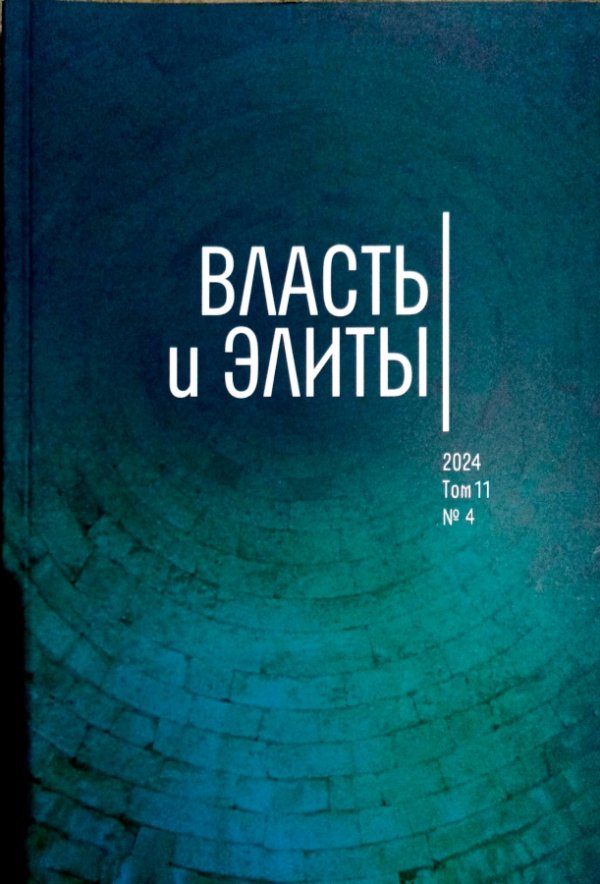Contextual moderations of electoral educational inequalities in European countries
- Authors: Safronov V.V.1
-
Affiliations:
- Sociological Institute of FCTAS RAS
- Issue: Vol 11, No 1 (2024)
- Pages: 40-70
- Section: ELITES AND POLITICS IN EUROPE
- URL: https://ogarev-online.ru/2410-9517/article/view/292112
- DOI: https://doi.org/10.31119/pe.2024.11.1.2
- EDN: https://elibrary.ru/NGJZJY
- ID: 292112
Cite item
Full Text
Abstract
About the authors
Vyacheslav V. Safronov
Sociological Institute of FCTAS RAS
Email: vsafronov@list.ru
ORCID iD: 0000-0002-5971-1777
SPIN-code: 7873-9356
ResearcherId: N-9740-2015
senior research fellow, Department of Sociology of Power and Civil Society St. Petersburg, Russia
References
- Сафронов В.В. Коррупция и электоральные классовые неравенства в европейских странах // Власть и элиты. 2023. Т. 10. № 1. С. 5–42. https://doi.org/10.31119/pe.2023.10.1.1. EDN: VFIYXP
- Сафронов В.В. Участие в выборах Государственной Думы: социальные неравенства, мотивации и мобилизация // Власть и элиты. 2023b. Т. 10. № 2. С. 121–169. https://doi.org/10.31119/pe.2023.10.2.6. EDN: ANXPUL
- Banducci S.A., Karp J.A. Electoral systems, efficacy, and voter turnout. The Comparative Study of Electoral Systems. Ed. by H.-D. Klingemann. New York: Oxford University Press, 2009. P. 109–134.
- Birch S. Elections and voters. Developments in Central and East European Politics Ed. by S. White, P.G. Lewis, J. Batt. Durham: Duke University Press, 2013. P. 156–170.
- Blais A. To Vote or not to vote? The merits and limits of rational choice. Pittsburgh: University of Pittsburgh Press, 2000. 208 p.
- Blais A. Turnout in elections. The Oxford handbook of political behavior. Ed. by R.J. Dalton, H.D. Klingemann. New York: Oxford University Press. 2007. P. 621–635. https://doi.org/10.1093/oxfordhb/9780199270125.003.0033
- Blais A., Daoust J.-F. The Motivation to vote: Explaining electoral participation. Vancouver: UBC Press, 2020. 156 p. https://doi.org/10.1080/00344893.2020.1837213
- Blais A., Dassonneville R., Kostelka F. Political equality and turnout. The Oxford handbook of political representation in liberal democracies. Ed. by R. Rohrschneider, J. Thomassen. New York: Oxford University Press. 2020. P. 396–412. https://doi.org/10.1093/oxfordhb/9780198825081.013.20
- Cancela J., Geys B. Explaining voter turnout: A meta-analysis of national and subnational elections. Electoral Studies. 2016. Vol. 42. P. 264–275. https://doi.org/10.1016/j.electstud.2016.03.005.
- Colton T.J. Transitional citizens: Voters and what influences them in the new Russia. Cambridge, MA: Harvard University Press, 2000. 336 p.
- Cruz J.N. A Fuzzy-set qualitative comparative analysis of how corruption, education, inequality and trust in parliament affect voter-turnout. Crime, Law and Social Change. 2023. Vol. 80. No. 5. P. 1–21. https://doi.org/10.1007/s10611–023–10102–0
- Dalton R.J. The Participation Gap: Social Status and Political Inequality. New York: Oxford University Press, 2017. 280 p. https://doi.org/10.1093/oso/9780198733607.001.0001
- DeBell M., Krosnick J.A., Gera K., Yeager D.S., McDonald M.P. The turnout gap in surveys: explanations and solutions. Sociological Methods & Research. 2020. Vol. 49. No. 4. P. 1133–1162. https://doi.org/10.1177/0049124118769085
- Gallego A. Unequal political participation worldwide. New York: Cambridge University Press, 2015. 252 p. https://doi.org/10.1017/CBO9781139151726
- Hadjar A., Beck M. Who does not participate in elections in Europe and why is this? A multilevel analysis of social mechanisms behind non-voting. European Societies. 2010. Vol. 12. No. 4. P. 521–542. https://doi.org/10.1080/14616696.2010.483007
- Jackson R.A. Clarifying the relationship between education and turnout. American Politics Research. 1995. Vol. 23. No. 3. P. 279–299. https://doi.org/10.1177/1532673X9502300302
- Kittilson M.C., Anderson C.J. Electoral supply and voter turnout. Citizens, context, and choice: How context shapes citizens’ electoral choices. Ed. by R.J. Dalton, C.J. Anderson. New York: Oxford University Press. 2011. P. 33–54.
- Kostelka F. The state of political participation in post-communist democracies: Low but surprisingly little biased citizen engagement. Europe-Asia Studies. 2014. Vol. 66. No. 6. P. 945–968. https://doi.org/10.1080/09668136.2014.905386
- Laakso M., Taagepera R. “Effective” number of parties: A measure with application to West Europe. Comparative Political Studies. 1979. Vol. 12. No. 1. P. 3–27. https://doi.org/10.1177/001041407901200101
- Lahtinen H., Martikainen P., Mattila M., Wass H., Rapeli L. Do surveys overestimate or underestimate socioeconomic differences in voter turnout? Evidence from administrative registers. Public Opinion Quarterly. 2019. Vol. 83. No. 2. P. 363–385. https://doi.org/10.1093/poq/nfz022
- Leighley J.E., Nagler J. Who votes now? Demographics, issues, inequality, and turnout in the United States. Princeton and Oxford: Princeton University Press, 2013. 232 p.
- McAllister I., White S. Demobilizing voters: Election turnout in the 2016 Russian election. Russian Politics. 2017. Vol. 2. No. 4. P. 411–433. https://doi.org/10.1163/2451–8921–00204002
- Persson M. Review Article: Education and Political Participation. British Journal of Political Science. 2013. Vol. 45. No. 3. P. 689–703. https://doi.org/10.1017/S0007123413000409
- Plutzer E. Demographics and the social bases of voter turnout. The Routledge handbook of elections, voting behavior and public opinion. Ed. by J. Fisher, E. Fieldhouse, M.N. Franklin, R. Gibson, M. Cantijoch, C. Wlezien. London and New York: Routledge, 2018. P. 69–82.
- Raudenbush S.W., Bryk A.S. Hierarchical linear models: Applications and data analysis methods. Second Edition. Thousand Oaks, CA: Sage. 2002. 512 p.
- Schlozman K.L., Brady H.E., Verba S. Unequal and unrepresented: Political inequality and the people’s voice in the new gilded age. Princeton and Oxford: Princeton University Press, 2018. 352 p.
- Selb P., Munzert S. Voter overrepresentation, vote misreporting, and turnout bias in postelection surveys. Electoral Studies. 2013. Vol. 32. No. 1. P. 186–196. https://doi.org/10.1016/j.electstud.2012.11.004
- Smets K., van Ham C. The embarrassment of riches? A meta-analysis of individual-level research on voter turnout. Electoral Studies. 2013. Vol. 32. No. 2. P. 344–359. https://doi.org/10.1016/j.electstud.2012.12.006
- Solt F. Economic inequality and democratic political engagement. American Journal of Political Science. 2008. Vol. 52. No. 1. P. 48–60. https://doi.org/10.1111/j.1540–5907.2007.00298.x.
- Stockemer D. What affects voter turnout? A review article/meta-analysis of aggregate research. Government and Opposition. 2017. Vol. 52. No. 4. P. 698–722. https://doi.org/10.1017/gov.2016.30.
- Verba S., Schlozman K.L., Brady H.E. Voice and equality: Civic voluntarism in American democracy. Cambridge, MA: Harvard University Press, 1995. 664 p.
- Wass H., Blais A. Turnout. The SAGE handbook of electoral behaviour. Vol. 1. Ed. by K. Arzheimer, J. Evans, M.S. Lewis-Beck. London: Sage. 2017. P. 459–487.
- Willeck C., Mendelberg Т. Education and political participation. Annual Review of Political Science. 2022. Vol. 25. P. 89–110. https://doi.org/10.1146/annurevpolisci–051120–014235
- Wolfinger R., Rosenstone S. Who votes? New Haven: Yale University Press, 1980. 160 p.
- World Social Protection Report 2017–19: Universal social protection to achieve the Sustainable Development Goals. Geneva: ILO, International Labour Office, 2017. 432 p.
Supplementary files











